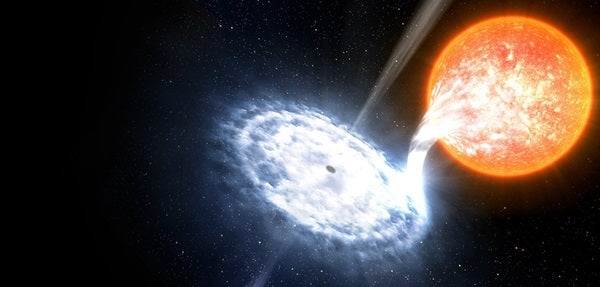Astronomers think quasars are driven by the intense energy escaping from the supermassive black holes in the hearts of galaxies. They result from infalling material from stars or nebulae that is captured and, sometimes, accelerated away again. Quasars were once commonplace because there used to be lots of stuff for black holes to gobble up, back in the good old days when the cosmos was more crowded. By contrast, most current supermassive black holes have devoured all the handy material in their vicinities and — like the one sitting in our Milky Way’s center — give off hardly a yelp, but instead hover quietly like patient spiders.
This is why it was such a surprise to find there quasar, albeit small ones, still making their presence known. And some aren’t even located in a far-off galaxy, but right here in the Milky Way. One such object is a mere 17,000 light-years from Earth.
Usually called XTE J1550–564, it’s located in the obscure constellation Norma the Carpenter’s Square, and therefore also has the designation V381 Nor. This object is a double or binary entity, in which one component is a normal star and its nearby companion is an orbiting black hole. They sit only 5 million miles (8 million kilometers) apart, a few Sun widths, so the outer atmosphere and wind from the visible star are quickly captured by its partner and flow into the black hole’s accretion disk. That’s the flat, pancake-like zone in which material spirals inward, faster and faster, until the gravitational and kinetic energy generated is converted into fierce heat. Some of the material never even finishes its death spiral; instead, it is emitted in a jet that gives off X-rays, which in this case is beamed in the direction of our planet.
Mini-quasars are handy because their activity levels scale with size, too. Events that would take days, weeks, or years to happen in a quasar are also scaled down. They happen in minutes, hours, or days in a microquasar.
The relevant event that grabbed everyone’s attention happened in 1998 when XTE J1550–564, which had never been noticed at all, suddenly got 1.5 times brighter than even the most intense high-energy X-ray source in the sky, the Crab Pulsar (see number 9 on our list). The Rossi X-Ray Timing Explorer satellite caught V381 Nor in the act of essentially exploding. By calculating the motions of the visible-star component, scientists easily determined the unseen X-ray-emitting companion outweighed any kind of non-black-hole collapsed object, such as a white dwarf or neutron star. The latter can never weigh more than about 2.14 solar masses (our Sun is 1 solar mass), while V381 Nor is about five times that; some astronomers even peg its mass a bit higher. This means that a black hole alone must be yanking on the infalling material, which is then heated to millions of degrees until it generates intense electromagnetic radiation in the most energetic part of the X-ray spectrum.
The “explosion” was actually an intense burst of material along the jets the black hole produces. How does it do that? V381 Nor’s intensely hot accretion disk is spinning as material inside it orbits the black hole at ever-shrinking distances. The disk produces an astonishingly powerful magnetic field that may be a trillion times more intense than Earth’s. Some captured charged particles from the visible star are grabbed and channeled along the magnetic poles of this system. Funneled off at half the speed of light, they are concentrated into two opposing lighthouse beams, one of which is by chance aimed our way.
To continue sending us this energy, these black hole jets need to be fed a constant meal of electrons, whose energies are in the trillion-volt range. You do not want to plug your laptop into this thing.
If the jets emitted by the black hole plow into interstellar gas clouds, they slow down a bit and transfer their energy. Over the course of about four years, gleeful astrophysicists observed this, too. Remember — this would have taken much longer, tens of years or more, to happen near a quasar. Though several million times smaller than the long-ago, now-defunct quasars seen in the distant hamlets of the cosmos, V381 Nor and microquasars like it are still alive and kicking, letting astronomers watch, in fast-forward, what life is like around a black hole.
Editor’s Note: This story has been updated for accuracy.












